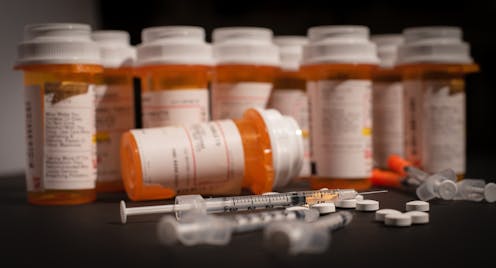How many Americans really misuse opioids? Why scientists still aren't sure
- Written by Joseph Palamar, Associate Professor of Population Health, New York University Langone Medical Center

With rates of prescription opioid use disorder[1] and opioid-involved overdose deaths[2] on the rise, the U.S. opioid crisis appears to be continuing unabated.
Data on overdose and death are pretty reliable. But there’s still much that’s unknown about opioid misuse that doesn’t lead to an adverse outcome such as overdose.
Drug surveys are reseachers’ main method of collecting data on opioid misuse. I’ve been in drug survey research for almost two decades, but in recent years I’ve learned that collecting accurate data on opioid misuse in particular is difficult. Why? Because many people underreport misuse, while others unintentionally overreport misuse.
Colleagues have been asking me how to ask about opioid misuse on surveys. I’m finding that there’s no easy answer. But one thing I’ve learned in my research[3] is that many people may misunderstand the basics about opioids, preventing researchers like myself from understanding the full scope of the epidemic.
Medical use and misuse
Drug surveys are already difficult to conduct, as many people lie[4] about use. For example, some people deny use to appear more socially desirable, and others simply try to finish the survey quickly without really reading it. But opioid surveys are especially challenging.
A friend of mine recently took my drug survey. She texted me the next day, saying she believed she incorrectly answered my opioid questions. Even though my survey asked only about using to get high or using without a prescription, she admittedly didn’t read the directions and reported misuse of dilaudid, a pain medication.
Situations like this lead some researchers to distrust reportedly high rates of opioid misuse. For example, a few years ago, my colleagues and I estimated[5] that 12 percent of high school seniors have ever misused prescription opioids. However, some of my reports focusing on such national data have (perhaps rightfully) been questioned[6], but we are limited by what people report.
On surveys, opioid misuse is sometimes defined[7] as using without one’s doctor telling you to do so. Other times, it’s defined[8] as using without a prescription. The most accurate definition[9] is use not directed by a doctor, including using opioids without a prescription or using greater amounts, or more often or longer than directed.
It’s important to include definitions of opioids and misuse on surveys. However, such definitions are meaningless if those taking the survey refuse to read them.
Misuse is also a confusing concept, as it is possible to use as prescribed and still enjoy the feeling resulting from use.
Lack of knowledge
Even though the public is now largely familiar with the term “opioids,” many people still don’t appear to know which drugs are opioids and which are not. For example, my colleagues and I discovered that a over a third of high school seniors[10] who reported nonmedical Vicodin or OxyContin use denied using opioids nonmedically overall. This suggests many users may be unaware that these drugs are opioids.
Opioids are commonly referred to opiates, painkillers, pain relievers, narcotics and analgesics. While “opioid” now appears to be the most common term, an individual familiar with the term may become confused when asked about different terms such as prescription painkillers or narcotics. The term “narcotics,” for example, can lead to confusion, as the Controlled Substances Act[11] also includes cocaine as a narcotic.
Confusion may also arise regarding drug names. For example, OxyContin misuse may be overreported by individuals who used weaker oxycodone formulations. Codeine misuse may also be overreported[12] by those claiming misuse of Tylenol III, which contains codeine, when they only used regular Tylenol.
I’ve also noticed that many people also don’t know the difference between methamphetamine, a potent stimulant, and methadone, an opioid. I learned about such confusion firsthand, after receiving multiple questions about methadone from social workers during a presentation I was giving about about methamphetamine.
Concoctions that contain opioids, such as “Sizzurp” (also known as “Lean” or “Purple Drank”), typically contain codeine cough syrup in a soft drink such as Sprite. Many users of this concoction likely deny codeine misuse.
It’s difficult to determine whether estimates of U.S. opioid misuse are too high or too low. Accuracy of these statistics is important, as they guide research, prevention, harm reduction and policy.
Researchers can use surveys to help educate people about opioids while collecting data. But first we need to figure out how to get people to read the questions.
References
- ^ prescription opioid use disorder (doi.org)
- ^ opioid-involved overdose deaths (www.cdc.gov)
- ^ research (www.tandfonline.com)
- ^ many people lie (archives.drugabuse.gov)
- ^ my colleagues and I estimated (www.drugabuse.gov)
- ^ questioned (doi.org)
- ^ sometimes defined (www.monitoringthefuture.org)
- ^ defined (www.cdc.gov)
- ^ definition (www.samhsa.gov)
- ^ over a third of high school seniors (doi.org)
- ^ Controlled Substances Act (www.deadiversion.usdoj.gov)
- ^ overreported (www.samhsa.gov)
Authors: Joseph Palamar, Associate Professor of Population Health, New York University Langone Medical Center

